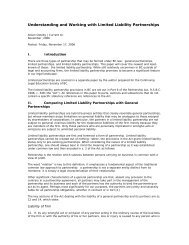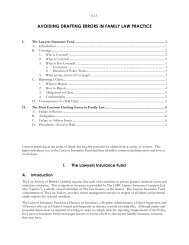Joint Ventures-The Limited Fiduciary Relationship Structure
Joint Ventures-The Limited Fiduciary Relationship Structure
Joint Ventures-The Limited Fiduciary Relationship Structure
You also want an ePaper? Increase the reach of your titles
YUMPU automatically turns print PDFs into web optimized ePapers that Google loves.
5.1.2<br />
I. Introduction<br />
Many larger business endeavours are carried on in some form of risk and capital sharing collaboration.<br />
For most of the last 200 years, these collaborations had primarily only two generally recognized legal<br />
forms: (i) partnerships and (ii) corporations. This paper will discuss the implications of an evolving<br />
legal structure, the joint venture (“JV”). In the US, JVs have only been recognized by courts and<br />
scholars as a separate form of business association since the mid-20 th century 1 and the JV has only been<br />
recognized as such since the 1970s in Canada. 2<br />
JVs represent subtle but important legal differences from the traditional partnership relating primarily<br />
to the challenges of “contracting out” of the law of fiduciaries. As such, some courts in the US do not<br />
recognize the JV as something unique 3 and some British and other authorities have treated the JV as<br />
merely a subset of partnership law. 4 In BC, however, the contractual JV is in frequent use and its legal<br />
attributes widely recognized by the courts with the most debateable issue in recent cases being the<br />
extent to which joint venturers assume fiduciary obligations to one another. [cite Blue Line]<br />
JVs are intended to be a more flexible form of business association (than a partnership or corporation)<br />
and similar arrangements are sometimes referred to using names such as: consortium, strategic alliance,<br />
collaboration, joint development, quasi-partnership, corporate joint venture and unincorporated<br />
association. Use of any of these types of nomenclature should alert the lawyer to the fact that the<br />
parties intend to create an agreement that is different from one that strictly falls into the realm of<br />
conventional corporate or partnership law and which may involve a joint venture or some overlap of<br />
these two traditional legal forms.<br />
This paper will outline the primary business and legal elements of what typically distinguishes a JV<br />
from a partnership. <strong>The</strong> focus of this paper will be on the “pure” JV which is strictly a creature of<br />
contract and hence often referred to as the “contractual JV.” <strong>The</strong> term “joint venture” is also used in<br />
circumstances which involve two parties collaborating through a special purpose corporation so the<br />
form or arrangement may be referred to as a “joint venture corporation.” Although this paper<br />
discusses the joint venture corporation (“JVC”), it does not deal extensively with this structure because<br />
the basic structure is a corporation, albeit augmented with a shareholders’ agreement and as such it is<br />
more governed by conventional corporate law although the shareholders agreement may superimpose<br />
many JV concepts onto the manner of managing the corporation.<br />
In the JVC, venturing parties who are generally the shareholders (but need not be exclusively)<br />
superimpose on themselves and the corporation they have formed, an agreement to deal with<br />
capitalizing, managing and winding up the jointly-owned corporate vehicle. <strong>The</strong> JVC is usually<br />
established with different objectives from most other corporations in that the JVC corporate vehicle<br />
usually has a relatively limited business purpose or life and may be operated not with a view to<br />
maximizing its profits but rather to developing an asset for the benefit of the shareholders. Likewise, a<br />
partnership which only has corporations as its members may sometimes be referred to as a joint<br />
venture partnership, corporate partnership or similar mixed usage terminology.<br />
1 S. Williston & W.H.E. Jaeger, eds., A Treatise on the Law of Contracts, 3 rd ed. (New York: Baker, Voorhis &<br />
Co. Inc., 1959) at 554.<br />
2 Central Mortgage and Housing Corp. v. Graham (1973), 43 D.L.R. (3d) 686 (N.S.T.D.).<br />
3 John I. Forry & Mark R. Joelson, <strong>Joint</strong> ventures in the United States (London: Butterworths, 1988) at 11.<br />
4 Barry J. Reiter & Melanie A. Shishler, <strong>Joint</strong> <strong>Ventures</strong>: Legal and Business Perspectives (Toronto: Irwin Law,<br />
1999) at 6.
















